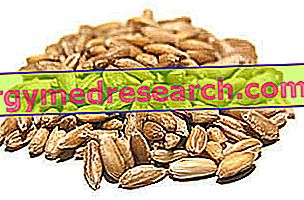The strong cereal
Spelled flour is the product obtained by grinding the caryopsis of Triticum spelta (or farro maggiore), Triticum dicoccum (spelled proper, or medium spelled, very similar to durum wheat) or Triticum monococcum (or small spelled). Spelled is a "strong" cereal, which grows on poor soils with a harsh climate: in similar hostile areas, other more delicate cereals - such as durum wheat, for example - are not able to develop.
Spelled flour in history

The diet based on products derived from spelled is particularly suitable for those who do not digest bread, pasta or other products made of hard or soft wheat.
Spelled flour is NOT recommended for coeliacs.
Nutritional analysis
When compared to other cereals, spelled has a reduced caloric intake: in fact, spelled only provides 335 Kcal per 100 grams (corresponding to 1, 400 Kjoules).
Spelled flour is particularly rich in proteins (15.1 g / 100 grams of flour) and in group B vitamins. Spelled contains an essential amino acid missing or lacking in many other cereals: methionine, involved in the synthesis of carnitine, cysteine, lecithin, taurine, phosphatidylcholine and other phospholipids.
Spelled is also very suitable for cooking ease and for its nutritional values, as well as for its versatility.
From the grain to the flour
Following threshing, the spelled grain retains the glumeal envelopes: in simple words, the spelled preserves a sort of film adherent to the seed, free of nutritional properties. In this regard, after threshing, the spelled grain cannot be transformed directly into flour: to remove the husk from the grain it is essential to have a decortication pass. Thus it is easy to understand why the cost of spelled flour (or spelled-based products) is so high (even 3-4 times higher than wheat flour). Given the high processing prices, most spelled flours consist of Spleta (spelled greater), which is less expensive and particularly versatile.
On the market there are two varieties of spelled: hulled and pearled. We have seen that after threshing, the spelled grain is subjected to decortication: the decorticated spelled keeps the pericarp (particularly rich in fiber) intact, which is instead removed in the pearl spelled. Between the two, hulled spelled is preferable, precisely because of its preciousness in terms of fibers; however, the pearly one is however very used, since it cooks in much shorter times. The flour can also be obtained from pearl spelled: the final product will be lighter and less rich in fiber.
Spelled flour: uses
Spelled flour is widely used for the production of sweets, pasta and bread. Baked products mixed with spelled flour are preferable to whole wheat ones: if whole wheat bread maintains a well-known bitter aftertaste, spelled bread is much more aromatic, similar to white wheat and, in some respects, even better.
Given the high fiber content of spelled, the products made with the homonymous flour help to regulate intestinal transit: the insoluble fibers preserve the ability to absorb water and therefore produce a mild laxative effect. The fibers consist of cellulose, lignin, hemicellulose and other complex polysaccharides, whose nutritional properties are nil; however, this does not mean that the fibers are very important for the body. In fact, reaching the stomach level, the fibers in the spelled flour swell: for this reason, spelled-based products also boast satiating properties.
Summary
Spelled flour: in short
| Spelled flour | Obtained from the grinding of the kernels of
|
| Spelled bread | Spelled bread has a flavor almost similar to white, but the aroma is more intense |
| Spelled flour and celiac disease | Spelled flour is not recommended for coeliacs. |
| Spelled flour: nutritional analysis | Spelled flour:
|
| Dehulled and pearled spelled | Decorticated spelled: spelled keeps pericarp intact → fiber rich in fiber Pearl Spelled: Pericarp is removed from spelled → it cooks in less time |
| Spelled flour: uses | Spelled flour is widely used for the production of sweets, pasta and bread |
| Property of spelled | High fiber content of spelled flour: → regularization of intestinal transit, mild laxative effect and satiating properties |



